Large four-wheel drive articulated tractors typically have been common in the Great Plains states of America and the western prairie provinces of Canada. Several tractor manufacturers were born in these regions to meet the growing demand for larger tractors to pull larger equipment. The Steiger tractor company of Fargo, North Dakota was the leader in this market, an innovator in bringing high horsepower tractors to the farmer. Their largest tractor in both sheer size and horsepower was unveiled in 1977. This was the Steiger “ST” Tiger series III tractor.
Steiger used two different tractor frame sizes to build its series III’s line of four-wheel drives—these were the ST or PT. The ST represented a Standard Frame (or wide frame as they were known), which was 46 inches wide on the Tiger III. A PT tractor had what Steiger called a “narrow” frame that measured 38 inches wide. The Steiger Wildcat, Bearcat, Cougar and Panther tractors had a common frame size built with onehalf inch thick steel plate, while the Tiger was in a class all by itself with an extra large frame that was 5/8ths inch thick steel. The use of thick plate steel for the tractors’ frame provided two features. First, it added critical strength in areas the tractor needed it without adding gussets or patch panels. Second, it added weight. Instead of using extra bolt-on weight plates or wheel weights, the Steiger frames were built heavy to give the tractor the weight it needed to get the power to the ground.
The Tiger III Was built in two similar, yet different versions—the ST-450 and ST-470. The ST-450 used a Caterpillar model 3408 V-8 diesel engine, while the ST-470 had a Cummins KTA-1150 six cylinder diesel engine. The model numbers 450 or 470 represent the rated horsepower of their respective engine.
Cummins KTA-1150 engine
The engine that powered the ST- 470 Tiger III was a Cummins inline six cylinder turbocharged and after cooled model KTA-1150-A. The KTA-1150-A had a displacement of 1,150 cubic inches. The engine was rated at 525 horsepower.
The large capacity engine aftercooler delivered cooler, denser intake air from the engine turbocharger to the intake for more efficient fuel burn and reduced internal engine stresses for longer life. The aftercooler was built into the engine cooling system, eliminating the need for special plumbing and such.
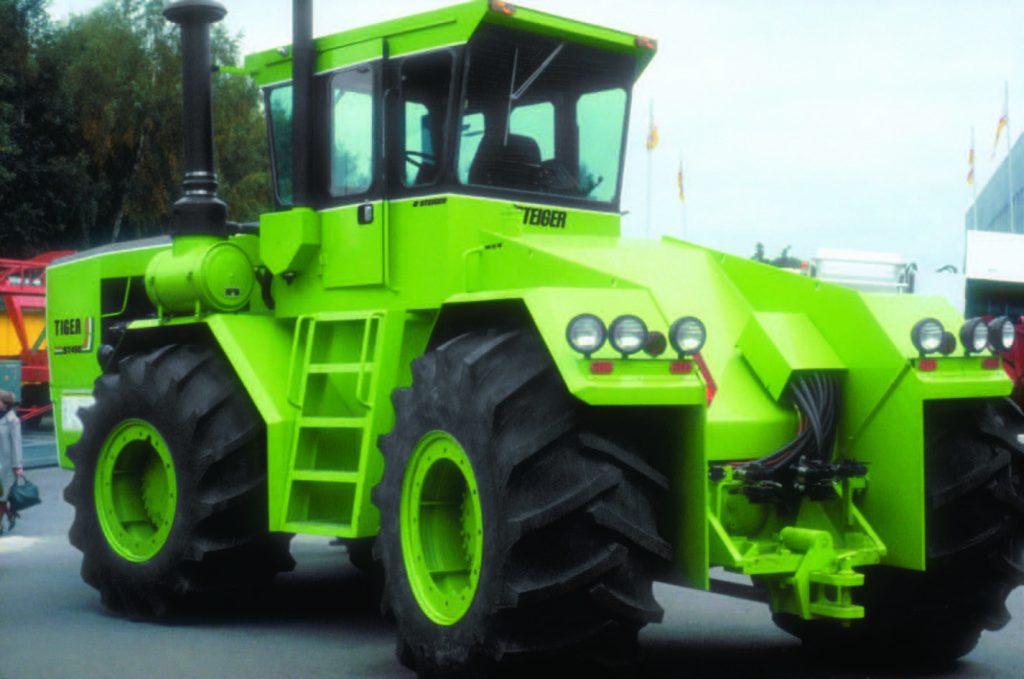
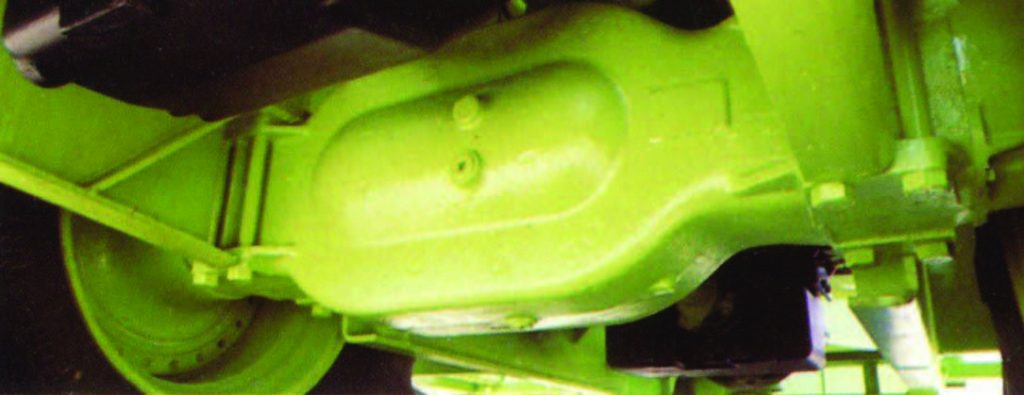
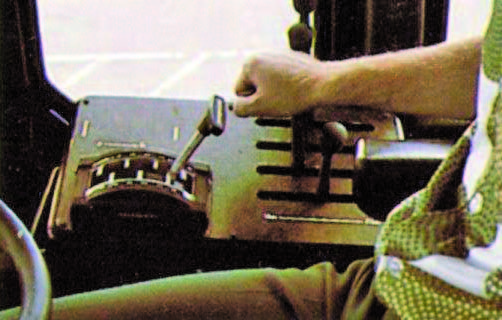
The massive engine weighed over 3,700 pounds alone and had removable wet cylinder sleeves. The fully counterweighted high tensile strength steel crankshaft rested on seven main bearings that were 5.5 inches in diameter. The drop forged I-beam style connecting rods had four inch diameter bearings. Each cylinder had its own alloy cast iron cylinder head.
The fuel injection system used on the KTA-1150-A was the Cummins brand low pressure PT type. This had camshaft actuated fuel injectors to give accurate metering and timing.
The engine could be termed one sided, in that the dual spin-on fuel and dual spin-on engine lube oil filters are both on the left hand side of the engine. The oil dipstick and fill tube were on the left hand side, too. This made daily maintenance and routine service changes of filters easy. The engine coolant filter and starter were on the right hand side of the engine block.
The KTA-1150-A held 13 gallons of engine oil. A block heater and ether assist starting aid were standard equipment. The KTA-1150-A engine measured approximately four feet tall and nearly five feet long. This was about the size of a garden tractor!
Caterpillar 3408 Dita engine
The engine that gives the ST-450 Tiger III its “purr” was a Caterpillar brand V-8, eight cylinder turbocharged and aftercooled diesel engine, model 3408. The 3408 had a displacement of 18.85 liters. The engine was rated at 450 horsepower.
The engine aftercooler delivered cooler, denser intake air from the engine’s turbocharger to the intake for more efficient fuel burn and reduced internal engine stresses for longer life. The intake air was passed over a “radiator” that used the engine’s coolant (it was colder than the air from the turbocharger) as its cooling source. When the hot air passed over the fins, the heat was exchanged and the net air intake temperature was reduced. Colder air is much denser than hot air. This allowed more fuel to be injected into the engine, thus creating more horsepower.
The 3408 Cat V-8 held 19 gallons of engine oil. A block heater and ether assist starting aid were standard equipment. To keep the Tiger running cool, a 40 inch diameter fan was used to pull air through the 2,088 square inch radiator. The coolant capacity of the tractor was 28 gallons. A large cooling system was needed to keep the Tiger running cool on hot days operating on the open prairies.
Transmission/ final drive
To put the 450-plus horsepower of the engine to the ground, Steiger used an Allison brand transmission model CLT-5965 with torque converter. This had six forward speeds and one reverse. Since the transmission was a power shift, there was no need to clutch between speeds—just move the shifting lever forward or backwards to shift up or down. This ease of operation could be important to the operator.
The Tiger III had dual planetary reduction drive axles made by Raba to Steiger specifications. The axle was a model K594 that featured five planetary gears located in the differential center housing and five planetary gears located in the wheel end housing. A spiral ring gear and pinion were used, too. Raba was located in Hungary and built many models of drive axles for Steiger. Raba also built licensed Steiger fourwheel drive tractors for the eastern European market.
Chassis
The rear frame of this tractor also served as the fuel tank. A whopping 267 gallons of diesel could be loaded into the tank and this would keep the ST Tiger III running all day (and a lot of the night) before stopping for fuel. The fabricated rear frame/fuel tank was built using 5/8ths inch thick welded plate steel. The fenders were built using one-quarter inch thick steel plate.
Steiger built the entire frame work at its factory from steel sheet stock. Skilled welders and heavy metal fabricators bent, cut, welded and formed the frame. Some robots were used for welding, but most was done by humans.
The cab steps are a good indicator to ID a TIGER model from the other Steiger tractors from afar. The steps on the Tiger are fabricated and mounted like ladder rungs. The other model Steiger tractors have a stairstep cab mounting step arrangement. This is a good method to distinguish the Tiger from the other models.
The all steel front hood tipped forward to allow complete access to the engine when servicing was needed. The front grille opened to allow access to clean the radiator when needed, too!
The ST Tiger III had a single center mounted brake disc that was 18-3/4 inches in diameter and mounted to the main driveline. The brakes had a hydraulic master cylinder with two stage action. A large piston was used to reduce pedal stroke and a small piston was used to reduce pedal effort. The ST Tiger III had a self adjusting foot pedal parking brake to keep the tractor in place when you needed it.
The turning radius of the ST Tiger III was a “small” 17 feet diameter. The ground clearance was 23 inches and wheel base 150 inches. It was fitted with 30.5 by 32 10 ply R-1 tires from the factory.
A 12 volt electrical system had a 90 amp engine mounted alternator and four 12 volt maintenance free batteries. The starting circuit was rated at 24 volts. To enable you to see at night, 14 sealed beam lights shone brightly. These bright lamps turned night time into daytime into work time. Four head lights were mounted in the grille and two lights on each front fender. Six rear filed lights illuminated the implement behind you. Cab mounted amber warning flasher lights with integral turn signals were also standard. Steiger used automatic reset type breakers in its electrical system.
The ST Tiger III was fitted with four remote hydraulic valves with a fifth valve being optional. The hydraulic pump capacity was rated at 38 gallons per minute of hydraulic oil flow.
A heavy duty roller, swinging type drawbar hitch was fitted to each ST Tiger III. The option of a three-point hitch and/or rear PTO attachment were never offered.
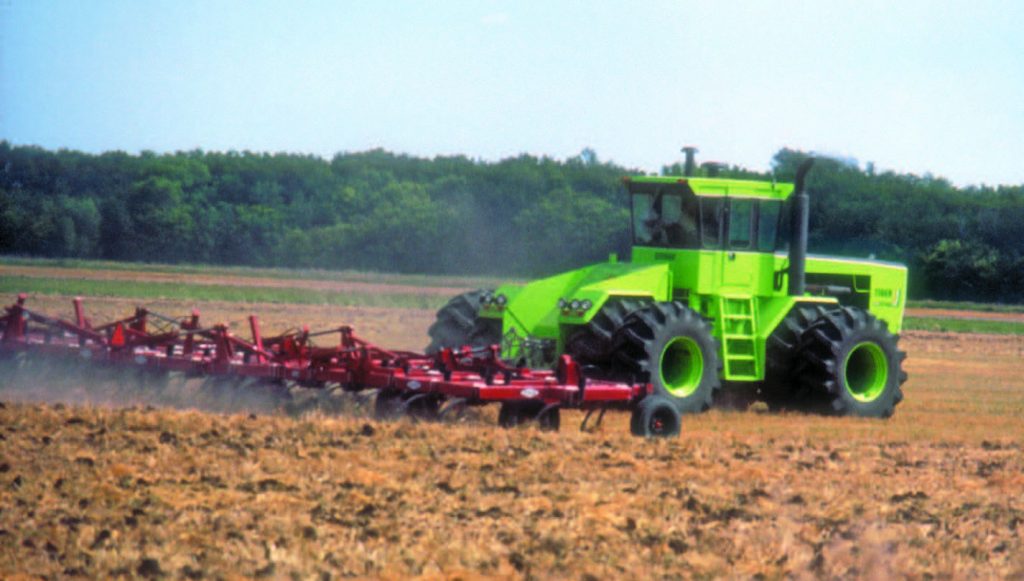
The cabin on the ST Tiger III was the Steiger designed and built Safari II cabin. This cab was ROPS approved and had isolated rubber mounts. Air conditioning and heat were standard equipment as were front and rear window wipers. Two cabine doors allowed you to exit the side you needed to save steps when attending to an implement. The right hand control console flipped up to allow access to the right hand door. The high back, deeply padded, cloth covered seat was built by Grammer and featured arm rests, fore-aft slide and lateral isolator. Inside the spacious cabin, you were surrounded by tinted glass to keep the sun’s rays out and that made you feel less tired and more productive.
A tilt/telescoping steering wheel could be adjusted to fit nearly any sized operator. Also included were cigar lighter, ash tray and beverage holder. There was also plenty of room beside and behind the seat to store extra tools, jacket, cooler or drinks and food. The black painted cabin interior also reduced glare.
An AM-FM stereo radio with cassette tape player and separate CB radio was standard on every ST Tiger III. With a cab sound level rated at 76.5 dB(A), you could hear the radio quite clearly. It’s quieter than some automobiles are!
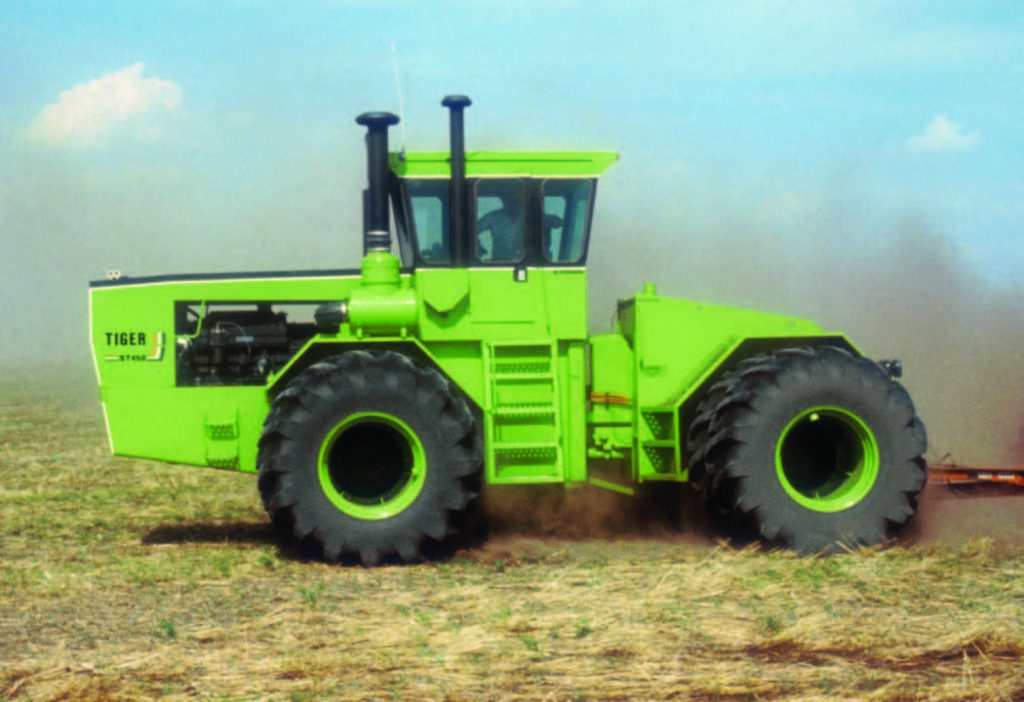
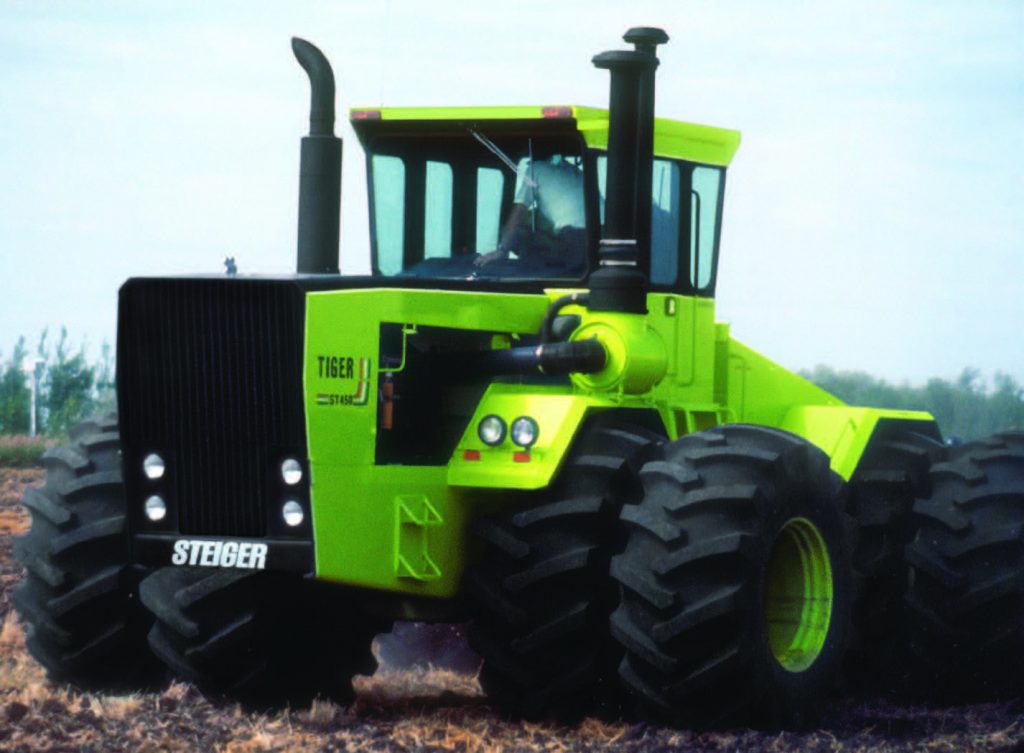
Something that every Steiger series III tractor had was black paint surrounding the cabin windows and the top of the bonnet was painted black, too. This was done to reduce glare from the sun. The bonnet paint was especially helpful. This author had spent some seat time in a series III during the bright summer days and the reduced glare from the bonnet top can make a world of difference on getting tired while driving. It is the little features like this that set the Steiger tractor line ahead of the competition.
This big tractor size led to big productivity in the field. You could disc harrow 40 acres an hour or field cultivate 500 acres per day. Did you need to pull a 70 foot field cultivator or 60 foot chisel plow? The Tiger III could do it! If you needed to moldboard plow ground fast, hitch an 18 bottom 18 inch cut plow behind a ST Tiger III and you could cover 160 acres a day.
The ST Tiger III could handle these implements and give you a comfortable ride pulling them, too! The ST Tiger III had a very short list of optional equipment. A no-spin front axle differential ($768), a fifth hydraulic remote valve ($379), windshield washer ($48) and tire/ rim choices were the only optional equipment.
The base list price for the ST-450 Tiger III was $171,556. The ST 470 Tiger II listed out at $176,167 (both prices are from 1981). These tractors were sold new with a one year/1,500 hour 100 percent coverage warranty. The ST Tiger III was built from 1977 to 1982.
The Tiger III tractors were initially labeled as the model ST-450 and had the Cummins KTA-1150 engine under the hood. In 1980, the Caterpillar 3408 direct injected turbocharged aftercooled engine choice was introduced at 450 horsepower. This then became the model ST-450. The Cummins KTA 1150 powered models were then rated at 470 horsepower and became the model ST-470.
The starting serial number of the Tiger III in 1977 was 131-00001. In 1978, the starting number was 131-00047. The year 1979 recorded a starting serial number of 131-00097. In 1980, when the Cat engine (CA) was added, the serial number list was split. The Cummins engine (CU) powered tractors had a starting serial number of 131-000174, while the Cat tractors used serial number 129-00007. The split numbers continued in 1981 with CU tractors starting at 130-000209 and the CA at 129-00010. The final year of production (1982) finished the split numbers with CA starting at 130-01501 and CA starting at 129-01501. Overall, Steiger built about 350 of the ST Tiger III tractors during their six year production run. The exact number left running today is unknown to this author.
The ST Tiger III had a shipping weight of approximately 40,750 pounds with standard duals and had a maximum warranted weight (weight covered by warranty for repairs) of 60,000 pounds. The Tiger III measured about 16 feet wide; this enormous size and weight limited the roads the Tiger III could safely travel on. Narrow country roads or bridges rated at 10 tons were no match for the Tiger III.
Steiger tractors were designed with a static weight distribution of 60 percent front, 40 percent rear. During field operation, the transfer of weight from the implement draft load occurred. This loading of the tractor provided an optimum 50-50 weight distribution for even four-wheel pulling power.




